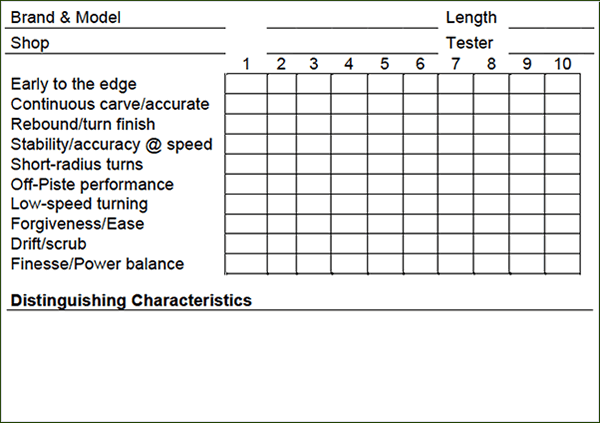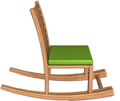The objective of on-snow ski testing is to pinpoint the behavioral matrix of any given ski so skiers can match its performance to their needs and expectations. This process requires a skier as well as a ski, and further requires all data to be filtered by a fallible human interpreter. We doubt there are enough qualified skiers in the US to create a sufficiently massive sample size to allow test results to rise to the level of statistical significance; in other words, it’s impossible to assemble a test team large enough to rely on the sheer weight of numbers.
Achieving a meaningful result therefore depends on several qualitative factors:
- The technical and communication skills of the individual tester. Ideally, a tester is proficient to the point he/she can imitate virtually any technique and has the language skills to identify and describe behaviors.
- How skis and/or skier types are categorized. When skis are tested in predetermined groups, as they are at all magazine tests, how any one ski fares depends in part on the coherence of the bundle. If a collection is a hodgepodge going in, the results coming out will be an indecipherable hash.
- The behaviors captured in the data. There should be a mix of criteria the testers are asked to quantify, including behaviors preferred/required by lower skill skiers as well as edge-of-the-envelope behaviors that help identify skis with the highest performance range. Verbal descriptions of the ski’s personality should complement and expound upon the model’s attitude and aptitude as depicted in the data.
- The balance of the test team. In some cases, such as testing race skis or pipe and park skis, it’s desirable to have a preponderance of highly skilled and highly specialized practitioners or else the testers won’t be able to put the ski through its proper paces. In all other categories – i.e., over 90% of the market – the team should reflect the composition of the world of experts, including ex-racers and current jibbers, but also instructors, coaches, former product developers, specialty retailers and a couple of local hotshots who can turn a ski and a phrase.
- The ability to mine the data to create viable comparisons across brands, meaningful behavioral snapshots by model and correlate each ski’s behavioral matrix to specific skier types. If there is a single argument that validates the ski test enterprise, it’s that manufacturers do exactly the same, usually with a smaller test panel, when deciding which of several prototypes to anoint as the next new model to join the line.
At the end of the day, there’s no way to tell how a ski is going to perform without skiing on it. (Most manufacturers also take the opportunity to ski their competitors’ products whenever possible.) All their R&D investment isn’t worth diddley if, when the ski hits the snow, the results are indifferent. It’s not that ski designers can’t predict what will happen when they add or subtract a feature from an existing template, but they can’t be sure, since changing any one thing in a ski can effectively change everything or result in just a minor fluctuation, like adding a hint of cinnamon to sangria.
The reference to wine is not an accidental simile, for the business of testing skis is a close relative to the rituals of wine tasting. Both are very experiential exercises that nonetheless presume to produce a numeric result, i.e., test scores and attendant first place awards. Their credibility rests on their methodology and the authenticated expertise of the test panel.
Test Panel Composition
Manufacturers get by with very small test teams because their composition is super-select, usually from the R&D staff and a handful of trusted athletes they’ve used for decades.
The major print magazines try to achieve what balance they can in an era of drastically reduced budgets. There’s less recruitment of great resumes and more assembly by convenience, the unfortunate consequence of having less to work with every year. There’s no shortage of skills and dedication to the task at hand—every tester is an expert skier giving his or her all to the cause—but there’s been a notable decline in the marquee quality of the major test teams over the last decade. I should know. I’ve been on one side or the other (manufacturer or tester) of ski testing every year since 1986.
When I orchestrated all alpine product testing for Snow Country Magazine in the 1990’s, I got the go-ahead to assemble an all-star cast. I imported a manufacturer’s methodology to the enterprise and, with the backing of the editor and publisher, devised several innovations that have since become standard: ranking winner skis in order of finish, showcasing the test team’s talents (which allowed readers to personalize the results), showing all scores by letter grade, along the way contributing instantly adopted terms such as “shaped skis,” to the sport’s lexicon.
We used to test skis for a month, and we paid our crew; no print publication can afford such luxuries in today’s market. I’m not saying that magazine buyer’s guides aren’t (usually) a valuable reference, only that they face certain inherent limitations. Like all ski tests, they’re dependent on the vagaries of the weather, with only a small window in which to match their bundles of skis to the snow conditions.
At realskiers, we dodge that bullet by testing at multiple venues over the span of several months. We capture data on many more models, from both mainstream suppliers and microbrands. Our crew, both male and female, is recruited from the ranks of some of America’s best specialty retailers. Most are lifelong skiers, dedicated—one might say, addicted—to catching as many hours on-hill as they can snag. Because their job is to match skis to skiers every day, they are particularly adept at visualizing who belongs on whatever ski they’re testing. They are elite skiers, but not elitists: they know there’s a ski for every skier and it’s their mission to identify it and communicate its benefits.
 Winners and Rankings
Winners and Rankings
Once a test director has loaded all the scores into a database, the biggest question of all must be addressed: how to parse and present the results? Organize the market by skier type or by ski category? Identify the top-scoring ski in each category or toss a blanket over all the reviewed skis and declare them all winners? Sift out the weakest models or show everything submitted by everybody? Present the reviews in alphabetical order by brand or list them in the order of finish? Show every score or no scores? Create a dizzying pile of symbols and pictograms and use them in lieu of prose to describe each ski? Present fine-grain categories with strict criteria or toss a mishmash of models into a pot, give it name like “Rippin’ Riders” and present the results as if the skis were all somehow related?
It’s all been done, and more. Here’s our solution at realskiers. First, the completed test cards are sorted by brand, model and category. The categories are defined by where and how the skier intends to use the ski, which we tie with realistic rigor to the ski’s width at its narrowest point underfoot. All of our category terms apply equally well to the skier, the ski and the venue where they are going to play together. For example, the “All-Mountain East” skier wants terrain and condition versatility suited to the eastern US resorts where he or she habitually cavorts.
We ask our testers to give us a numeric score (on a 1 –10 scale) for ten behavioral criteria. Four of the criteria focus on technical properties that favor more proficient, fast and/or powerful skiers: Early to the Edge, Continuous Carve, Rebound, Stability at Speed. These behaviors form the core of our Power score.
Four “softer” criteria – Low-speed turning, Forgiveness, Drift and Short-radius turns – reflect the concerns of less aggressive skiers and are mainstays of our Finesse rating. Off-piste performance, which includes moguls and tree skiing as well as powder, and Finesse/Power balance are also worked into the Power and Finesse formulae.
For each category, we present our Power Picks separately from the Finesse Favorites as they represent two very different expectations on the part of the skier making the buy.
To earn a Recommended Medallion, a ski has to score over 80% for either Finesse or Power, or, as is commonly the case, for both. Letter grades are applied on a sliding scale pegged to the highest scores for Finesse and Power. If a ski isn’t an “A” student, it isn’t likely to graduate to Recommended status.
If it seems we end up with a lot of “A” students, remember that we’re skiing preponderantly high-end, expensive skis: they ought to be good. This doesn’t mean every ski we essay earns a medallion: this season our percentage of Recommended skis was 55% of the total number tested and reviewed. Every model that makes our cut we consider worthy of our readers’ consideration.
To see the full test range (US market) of any brand’s ski collection, please refer to our brand-specific results.
Keep your Eye on the Prize
We endeavor to keep our focus on the ultimate purpose of the enterprise: help skiers find the best ski for them to buy this season. We’re not trying to track down and describe every ski being made in the world as this has become not only very difficult but at the end of the process, not very useful. There are more than enough extraordinary skis being presented here to make searching elsewhere unnecessary. Don’t turn the search for your next ski into a fetish; leave that to us. Believe me, you don’t want every ski day to be a test day. It’s better to fall in love and remain faithful, at least for a couple of seasons.
We want to be your dating service. Perhaps the best reason to look closely at ski tests is that they have sufficient influence on the market to create scarcity before consumers ever have the chance to try them. As I write this in the spring of 2013, the Blizzard Bonafide represents a case in point. For two years running, SKI magazine (and other oracles) declared it the best ski in its class, resulting in all Bonafides being gone before many natural snowflakes had appeared. You might think Blizzard should learn to make more skis, but all ski companies have banks looking over their shoulders, limiting their risk exposure. Overall, the ski market is hurting mightily, and the success of one model doesn’t insure huge financial gains. But having star products certainly helps a brand’s profits and helps build a reputation that can carry it through a dark period like the one being endured now.
If skis were only $199, nobody would be terribly concerned about making a buying boo-boo. But with a good ski and binding hovering around a grand, skiers feel more like they’re committing to an arranged marriage rather than indulging in a brief dalliance. People don’t want to live with a mistake for a decade. So people are going to search for some authentic validation that will give them the security to make a buying decision.
There’s nothing more authentic than one’s own experience, which is why savvy skiers demo any model they fancy before diving into the deep end of the pool. In this case, a ski test like the one conducted by realskiers provides the skier with a means of thinning the herd down to a practical number of candidates.
How to Demo
Since our site may well be used for just such a purpose, allow me to digress to address the subject. There is a right way to go about the process and all kinds of wrong ways. To do it right, begin by reading our reviews and background articles to get a feel for the market and where you fit in it. Narrow your choices down to no more than 5 skis. This is, in fact, too many, but we’ll narrow the field in the next step, which is finding a shop that carries the models on your candidate list. You probably won’t find all 5 under one roof, so there’s your next cut.
Ask the shop what their demo program is and when you’ll be able to try them. Don’t be surprised if it isn’t until January as no sane shop sends their demo fleet out when coverage is light. So let’s assume it’s January and you’ve found a benevolent shop that has 3 skis on your 5-ski hit list and they apply the $40/day demo charge to purchase for up to 3 demos. Ideally, you’ll ski the 3 contenders back-to-back in the same, appropriate snow conditions, or as close to this ideal as you can get. Then act: pick your favorite, plunk down your credit card and settle into your new relationship. Do not find 3 more skis to try, then another 3, and so on, hypnotized by a sort of demo narcosis. Chances are that you’re probably not a trained professional ski equipment tester, so adding to your testing duties (and costs) probably won’t improve the result.
There is also the likelihood that one or more of your demo skis will be in sub-optimal tune, which makes achieving a coherent result virtually impossible. The issue of tuning will most likely decide the outcome of your on-hill evaluations. How well a ski is tuned has an inescapable effect on its performance, whether that ski is being demoed by you, Dear Reader, or tested by one of our crew. A bad tune dooms any hope for a favorable impression, while a superb tune can make a dog at least respond to a couple of commands.
Remember this when you finally adopt a ski and take it home: it needs constant love and reinforcement in the form of wax and edge polishing to achieve at its highest level. Don’t hold your skis—and yourself—back from achievement by shackling your babies with an indifferent base tune. Be nice to your skis and they will continue to be nice to you.
Test Methodology
Ski testing is not the same thing as skiing. It’s a discipline, once deemed important enough that standards were written to delineate the conditions and parameters under which a serious ski test could be conducted. Of course, that was back in the horse-and-buggy days of straight skis. The only acceptable surface was hard snow; anything else would disguise critical behavioral nuances.
Today, hard snow performance is only one aspect of a ski’s total measure, and in some ski genres, like Big Mountain and Powder, not a very important one. When I began orchestrating equipment testing at Snow Country Magazine, I imported a test methodology adapted from my product development work at Salomon. It included criteria such as “Glide” and “First Impression,” which, while still important today, can’t fit in among all the competing sensations one needs to register in a single, ski-scoring descent.
The skis being scored this winter by the realskiers test panel will be rated for ten criteria on a 10-point scale. As mundane as this may seem, ski tests with 100-point scoring systems are rare, and the 10-point scale matters more than it appears to. Testers are now asked to differentiate among over 20 models in a given category; a 5-point scale doesn’t leave a lot of wiggle room, resulting in an over-abundance of tie scores. The change in our scoring system should create more spread in the results and therefore a clearer picture of each ski within its genre.
The Card
The Criteria
Early to the edge
If the edge can’t hold, trajectory depends on the caprice of drifting. As most skiers spend their time on groomed runs, edging is a primordial property. With the increase in rockered, blunt-snouted tips not intended to engage early, how quickly a ski gets to the edge becomes the primary differentiating trait.
Continuous carve/accurate
Once the edge is set, how clean is the arc? Does it ever waver, quiver or quake? Some skis feel like magnetic rails, others like oil-dipped eels. This vote is for the rails.
Rebound/turn finish
Skis manage the transition between turns in many ways. Some hang on the edge languidly across the hill, others leap off the snow as if it were a hot iron, some spool turn to turn in the fall line like spun silk. But however it reacts at the bottom of the turn, does the ski help the skier finish one arc and segue to the next?
Stability/accuracy @ speed
If you paid a lot for your skis, one of the things you paid for was this property. The best skis in the world don’t break down even when the vibrations underfoot would fracture granite; they just hum louder. One reason ski testers had better be good is that you can’t test this characteristic if the pilot can’t operate calmly at top velocity.
Short-radius turns
Short-radius turns are made, not born. Even skis with small meter-radius measurements won’t make a tidy little turn unless you ask for it. But when you set a high edge angle, how rattlesnake-quick is the ski on and off the edge? Can you cut short, sinuous, high-energy arcs without ever losing edge contact?
Off-piste performance
Note that the criterion isn’t “flotation.” A ski’s footprint tells us that; fatter skis float higher: big deal. How do they function in ungroomed conditions? Are they deflected by piles of set-up crud? Do they glide through cut-up snow? Do they conform to irregular terrain, i.e., bumps? Can they snake through the trees? There’s a big world off trail, and most of it is already tracked.
Low-speed turning
Not everyone thinks of his binding’s AFD pad as a gas pedal. Some people like making turns for their own sake, short, secure arcs that keep acceleration in check. All Finesse skiers prize this property; most Power skiers are unaware it exists.
Forgiveness/ease
How uncoordinated or careless can you be and still stay upright? If you try to drive from the back seat, can you still buy a turn? How effortless is the overall experience? Can you work less and enjoy life more? Or does the ski slap you silly if you get loose or late?
Drift/scrub
For some skis, smearing a turn is a way of life; for others, it’s an abomination. For most skiers, some capacity for scrubbing sideways is essential; it’s known as speed control.
Drifting isn’t just for powder and bumps: the best racers in the world incorporate some foot steering in their turns and depending on course setting and conditions may be required to drift to win. At the World Cup level, this is called the Stivot.
Finesse/Power balance
Everyone wants a ski that does it all. How well does this ski do everything, from carve to drift, from slow speed to fast, from short turn to long? Does it reward great skill without requiring it? Higher scores indicate greater versatility.
Comments and distinguishing characteristics
Scores are useful for rankings, but they don’t tell the whole story. At the end of the day, words do a better job of capturing behavioral nuances than numbers do. But words are harder to conjure up than numbers, which makes the spot-on verbal snapshot the most prized distillate extracted from any on-snow endeavor that attempts to encapsulate a ski’s special qualities.
How to Use Our Ski Reviews
Find Your Category
The first step in picking your Perfect Ski—our signature feature—is accurate self-assessment. This begins with a few straightforward questions: where do you ski? What resort, in what conditions, on what type of terrain? Are you predominantly an eastern skier or a western skier? This shouldn’t be open to conjecture nor is there any advantage in inflating your resume. The realskiers categories revolve around the terrain requirements of the skier; if you don’t know where you’re going, any ski will get you there.
For 2017 we’ve made a slight adjustment in the boundary between Technical and Frontside models,moving it to the 74/75mm cusp to reflect a market shift of a few Technical models with 74mm waists. All of our categories have the same definitions and unifying traits that we’ve used for the past several seasons. The defining trait that segregates our model categories is waist width: manufacturers now create a new iteration of an expert ski at roughly 10mm intervals.
Our categories are, in ascending order of waist width:
Non-FIS race
Today’s race skis represent the very highest achievement in the art of ski making. Brands like Head, Stöckli, Atomic and Fischer are obsessed with making the most immaculate race skis they can concoct because that’s where you’ve got to have your A game in order to compete.
Technical (men’s and women’s)
Technical skis are invariably high performance, hard-snow carving models that embody race ski properties and sport similar dimensions, although they aren’t actually intended as gate skis but as hard snow toys for people who probably had race training in the misty past.
Frontside (men’s and women’s)
This category (75mm-84mm) encompasses the broadest range of skier abilities, from never-ever to the fall-line fanatic. Almost every entry-level ski for the neophyte falls into this family, but there are also a plethora of choices for skiers who prefer to fly around at 50 mph. The intended terrain is almost exclusively groomed, but the wider bodies within this family will travel off-slope if asked. Because carving turns is the aspirational activity associated with skiing groomed trails, this genre is often tagged with the “Carving” label, but we’ve chosen “Frontside” as a more ecumenical term that accommodates the needs of the multitude of non-technical skiers in the on-piste cadre.
All-mountain East (men’s and women’s)
All-mountain East skis (85mm-94mm) are a match for skiers who ski groomed trails most of the time but who want the freedom to foray into the untamed backside when conditions merit. The cream of this crop has settled on a waist width of 88mm or 90mm underfoot, creating an extremely versatile profile. They make excellent “re-entry” skis for consumers who have been out of the ski market for several years. This is the ideal category to search for a one-ski quiver for the advanced woman skier.
All-mountain West (men’s and women’s)
If there is a single, do-it-all ski—particularly for western skiing—it no doubt lives in this category and probably has a waist width of 98 or 100mm. The reason: up to this girth (95mm-100mm), these relatively wide skis don’t feel too fat underfoot; they ride the groomed almost like a Frontside ski yet provide as much flotation in powder as possible without the width morphing into a negative when the powder is gone. Ski makers recognize the importance of this genre and therefore give it their very best efforts, creating a rich array of options for the high performance skier.
Big Mountain (men’s and women’s)
It wouldn’t be unfair to lump all skis over 100mm at the waist into a giant bucket labeled “Powder” and leave it at that. Conventional “wisdom” holds that the fatter the ski the better the flotation, so just pick a ski based on how high you want to ride on new snow and you’re good to go.
Or not . . .
We cleave the powder pie in two because there are big behavioral differences between the Big Mountain bundle of skis (101mm-113mm) and the cluster over 120mm. The best of the Big Mountain brotherhood are everyday skis for strong riders on—you guessed it—big mountains, but there also are easy riders in this corral, skis that will help the less talented whip their powder skills into shape.
Powder
The fattest of the fatties (>113mm) are true specialty sticks, meant for when the snow is so deep even a 108mm won’t float high enough. This reality won’t keep some folks from sporting them every day, but hauling a barge around on hard snow is no picnic for the knee joint and qualifies as lunatic-fringe behavior. If you live in the West, it makes sense to own a Powder board as a second pair; if they’re your only skis, we hope you also own a helicopter.
We’ve said it elsewhere, but it bears repeating: we do not advocate using a ski over 100mm underfoot as your everyday ski unless you are a professional heli guide. If your skills are less than legendary, a narrower ski is a better coach; a wider ski is more like a drunk baby sitter: you can get away with murder, but it’s not in your best interests. So unless you’re shopping for a second ski, the rocks you want to look under are labeled Frontside, All-Mountain East or All-Mountain West.
To ensure complete coverage of Non-FIS Race and Technical models, at the end of the 2014 and 2015 seasons I organized short, on-snow sessions to capture data on skis I was concerned my regular methods might miss. I didn’t reconvene a similar session this past spring and as a result several stellar models from Atomic, Salomon, Nordica and Head didn’t receive the coverage they deserve. I’ll be sure to get more feedback on the models we missed during the year ahead.
All our test cards came from our wonderful test shops. Our deepest gratitude to every skier who took the time to fill out a test card; without you, we’d have bupkis.
If you’re a park rat, you probably already know you’re in the wrong place; this is a directional site. Likewise, if you want to know how well any of these skis hike uphill, there are sites that ably address your concerns, including skimo.co, North America’s first specialized skimo gear resource and a realskiers partner.
Now we come to the next stage in our ski selection triage. We assume that you possess at least modest skills or else you wouldn’t be ski shopping. The ocean of “advanced” skiers to which you most likely belong is wide and deep. There are many ways to parse it, but there is one defining divide: is the skier a technical athlete able to create and hold high edge angles regardless of speed and surface condition? This is when a rigorous self-evaluation matters. If you can honestly say you know how to tip it and rip it, it’s safe to shop among our “Power” favorites. They were selected for their performance, not their affability.
If you’d rather find a more forgiving, friendly ride you should shop among our Finesse favorites. They focus on enhancing accessibility to new skills and/or terrain, the helping hand that new technology is supposed to provide.
Reading Reviews
(Please note: skis we test are made available to our panel by representatives of the manufacturers and, with rare exceptions, are tuned to manufacturers’ specifications. Any deviation from those specifications can affect your ski’s performance to the degree that our reviews may not remain pertinent. In particular, tunes that are more aggressive than those recommended by the manufacturer can degrade the usability of the ski.)
For any given model, the hard data includes sidecut dimensions (mm), turn radius (m), available sizes (cm), weight for a single ski (g) and suggested retail price (US$).
A word about numbers: While we are confident in the relative accuracy of our numbers, please bear in mind that there are subjective factors at work; it’s more than just cut-and-dried numerical formulas. It is also important to know that performance scores and Finesse/Power ratings are relative only to other skis in a given genre; you can’t compare the results for a Worldcup slalom to those for a pure Powder plank.
The little boot and ski icon in the heading reveals the baseline profile, or how the ski is cambered and/or rockered along its length. While it seems as though each brand has its own flavors of “rocker”, we identify four simplified general profile families:
- Front rocker
- Tip and tail rocker (camber underfoot)
- Full rocker (no camber)
- No rocker (traditional camber)
The symbols designate profile family and divide ski designs into four general groups. We do not differentiate between twin tip and and flat tail models, nor between modest early rise and more dramatically rockered tip designs.
Full Rocker

Think of a rocking chair . .
Tip Rocker
Skis with rockered tips that are also traditionally cambered, what some companies call ‘resort rocker’ or early rise, we designate as tip rocker. Skis like this handle crud and other bumpy features well and are as a rule less technically demanding than skis with traditional camber, especially on ha
Kind of like the old classic American Flyer sled . . .
Tip and Tail Rocker
With the near-universal adoption of some form of rockered baseline, Tip and Tail rocker, aka Double Rocker, has become commonplace among All-Mountain and Big Mountain genres. The degree of tip elevation is often double the degree of lift at the tail as the presumption is the skier is heading forward downhill.
Skis with Tip and Tail rocker are likely to have tapered tips and tails, too. “Taper” in this context means the forward contact point has been pulled back and the rear contact point moved forward so the extremities end up shaped with an extended flat zone, like a canoe paddle.
Traditional Camber
Traditionally cambered skis are technical skis, although they are becoming increasingly rare, as even Worldcup athletes are beginning to appreciate the benefits of slight early rise. These skis 
Imagine an inverted leaf spring . . .
Silver Skier Selection
Over the past several seasons I’ve worked the sales floor at Bobo’s, a specialty ski shop in Reno, Nevada. This activity affords a fabulous view of the skiing public as Bobo’s serves the full spectrum of skier types and offers an almost absurd range of choice. In interview after interview of skiers over 50 I hear some version of the same refrain: “I don’t ski as aggressively as I used to. I’m more cautious and I tire sooner.” This skier, whether male or female, wants a model that will make the sport easier and less exhausting so he or she can enjoy a longer ski day.
To serve this growing segment of the skiing public, Realskiers has identified specific models that I feel are particularly well adapted for senior skiers. In conjunction with Senior Skiing, a specialty site devoted to the concerns of the silver-haired skier, Realskiers is awarding a Silver Skier Selection to skis that take care of the senior skier.
Brand Profiles
At realskiers, we’re connected to the market. We not only know the players, we helped write the playbook. We realize that the models we prefer don’t cover the full spectrum of quality skis; we also know that every catalogued ski isn’t necessarily widely available.
In the interests of reducing clutter and more accurately reflecting what’s on dealers’ walls, we pare our reviewed models down to those likely to find good homes around America. Chances are, whatever mainstream model isn’t covered in the 2016/17 universe can probably be found in our previous year’s archives.
With the wild proliferation of small-batch ski makers it’s become impossible to corral and analyze every ski one might find on the world market. Not all small brands are worthy of consideration, but a few stand out both in terms of quality and in their determination to build a presence among specialty retailers. My market analysis guided me to Faction and Black Crows, both ten-year old brands founded by professional freeride skiers who couldn’t find the skis they wanted so they decided to build their own. I’m happy to report our test panel rose to the occasion and provided enough test cards for me to evaluate – and Recommended – a few models from our newest participants.
Every brand I review begins with a brand profile, an overview of its history and an update on where the brand stands today. This may seem like superfluous padding, but if you understand a brand’s roots you get a better grip on what kinds of skis they’re best at building. I strongly urge all Realskiers visitors to read the associated brand profile for any model seriously under consideration.
Made for Each Other: the FIND button 
When you buy a ski, you’re acquiring a collection of behaviors. The narrative that accompanies each model is a capsule report of that behavior. We try to evoke the experience of coming down the mountain, which is what you’re paying for.
The reasons we’re trying to match you to your perfect ski are twofold: one, we want to help you make the right choice, and two, we care where you consummate your new relationship. Trust us when we say that the shekels you save by shopping solely on price are a pittance compared to the value of a great boot fitter, a master tuner and someone who knows how it’s all supposed to work together.
When you hit the FIND button, don’t panic, you haven’t bought anything yet. What you’ll see is a menu of dealers we have vetted and believe represent your best choices. We strongly encourage you to patronize one of these retailers as they have the requisite professionalism to serve those needs we can’t predict or prescribe from our vantage point.

 Winners and Rankings
Winners and Rankings






